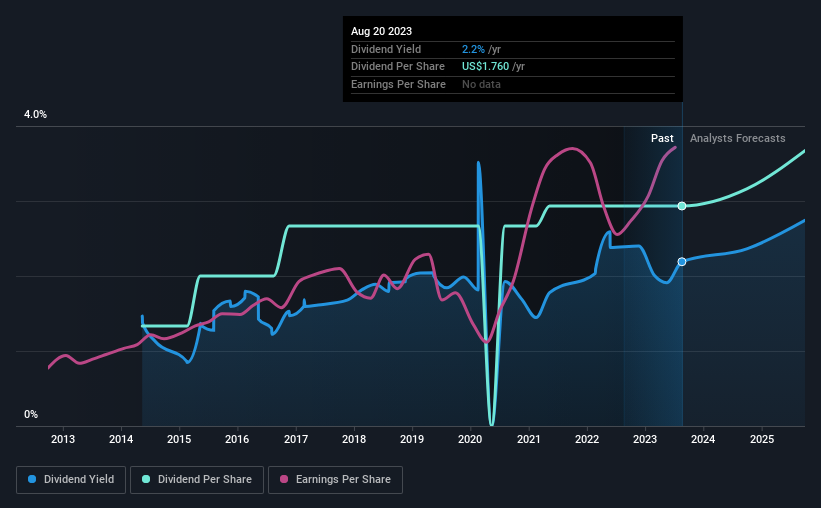- United States
- /
- Hospitality
- /
- NasdaqGS:JACK
Jack in the Box (NASDAQ:JACK) Is Due To Pay A Dividend Of $0.44

Jack in the Box Inc. (NASDAQ:JACK) will pay a dividend of $0.44 on the 18th of September. This means that the annual payment will be 2.2% of the current stock price, which is in line with the average for the industry.
View our latest analysis for Jack in the Box
Jack in the Box's Payment Has Solid Earnings Coverage
Solid dividend yields are great, but they only really help us if the payment is sustainable. However, prior to this announcement, Jack in the Box's dividend was comfortably covered by both cash flow and earnings. As a result, a large proportion of what it earned was being reinvested back into the business.
Looking forward, earnings per share is forecast to rise by 19.5% over the next year. If the dividend continues on this path, the payout ratio could be 21% by next year, which we think can be pretty sustainable going forward.

Jack in the Box's Dividend Has Lacked Consistency
Jack in the Box has been paying dividends for a while, but the track record isn't stellar. This makes us cautious about the consistency of the dividend over a full economic cycle. The annual payment during the last 9 years was $0.80 in 2014, and the most recent fiscal year payment was $1.76. This implies that the company grew its distributions at a yearly rate of about 9.2% over that duration. It's good to see the dividend growing at a decent rate, but the dividend has been cut at least once in the past. Jack in the Box might have put its house in order since then, but we remain cautious.
The Dividend Looks Likely To Grow
Given that the dividend has been cut in the past, we need to check if earnings are growing and if that might lead to stronger dividends in the future. Jack in the Box has seen EPS rising for the last five years, at 14% per annum. Growth in EPS bodes well for the dividend, as does the low payout ratio that the company is currently reporting.
We Really Like Jack in the Box's Dividend
Overall, we like to see the dividend staying consistent, and we think Jack in the Box might even raise payments in the future. Earnings are easily covering distributions, and the company is generating plenty of cash. All in all, this checks a lot of the boxes we look for when choosing an income stock.
It's important to note that companies having a consistent dividend policy will generate greater investor confidence than those having an erratic one. Meanwhile, despite the importance of dividend payments, they are not the only factors our readers should know when assessing a company. For example, we've identified 2 warning signs for Jack in the Box (1 is significant!) that you should be aware of before investing. Looking for more high-yielding dividend ideas? Try our collection of strong dividend payers.
New: Manage All Your Stock Portfolios in One Place
We've created the ultimate portfolio companion for stock investors, and it's free.
• Connect an unlimited number of Portfolios and see your total in one currency
• Be alerted to new Warning Signs or Risks via email or mobile
• Track the Fair Value of your stocks
Have feedback on this article? Concerned about the content? Get in touch with us directly. Alternatively, email editorial-team (at) simplywallst.com.
This article by Simply Wall St is general in nature. We provide commentary based on historical data and analyst forecasts only using an unbiased methodology and our articles are not intended to be financial advice. It does not constitute a recommendation to buy or sell any stock, and does not take account of your objectives, or your financial situation. We aim to bring you long-term focused analysis driven by fundamental data. Note that our analysis may not factor in the latest price-sensitive company announcements or qualitative material. Simply Wall St has no position in any stocks mentioned.
About NasdaqGS:JACK
Jack in the Box
Operates and franchises quick-service restaurants under the Jack in the Box and Del Taco brands in the United States.
Undervalued average dividend payer.
Similar Companies
Market Insights
Community Narratives



